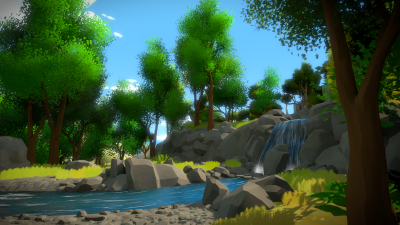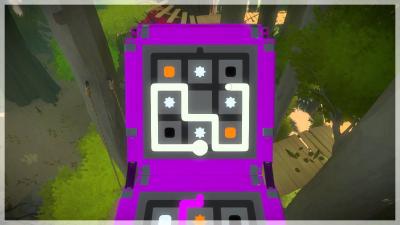Allegory of the Witness
SPOILER WARNING: I wanted to share my views on the subject matter in The Witness. By necessity, this article does discuss the ending of the game in general terms. However, I do my best to avoid talking about specifics.
When I started writing this review, it began with “I liked The Witness, BUT…” I was frustrated. I couldn’t fathom what the ending meant. What I was supposed to glean from this experience? How do the voice-overs fit together? Why was I shown this?
But then I had an epiphany: I felt this same frustration before. Many times. Every time I solved a puzzle in the game. And so I began to see the prevalent puzzle mechanic as a metaphor for the game itself. “Solving” the story isn’t the point.
I recommend The Witness. If you’re considering playing it, do it. But bear in mind that it’s not a traditional story, and you may be disappointed if you treat it that way.
What is The Witness?

The river that flows through the island. Courtesy of The Witness media page.
The Witness is a first-person puzzle game released on January 26, 2016. Its gameplay is non-linear and very visual (evocative of the Myst series). The art direction feels similar to that of Team Fortress 2: natural, simplified, and impressionistic.

A typical puzzle. Image from here.
Any discussion of The Witness must mention the puzzles. It’s the core mechanic in the game. You start at the circle and draw a line to the line cap (like the one at the top of picture). As you can see, there are other pieces, but the joy of the game is discovering their meaning and how they interact. It’s a perfect information puzzle, so the only limit to solving any given puzzle is your ingenuity and background knowledge. This is simultaneously the most satisfying and the most frustrating part of the game.
The Allegory
There’s a lot of speculation around what the game is about and what the ending means. I don’t claim that this is the definitive interpretation or even a good one, but it’s the one that resonated with me.
Without giving too much away, when you arrive at “the end”, the scene that unfolds seemingly erases all of the progress you’ve made. I felt cheated. But then I stumbled onto an idea that redeemed the ending for me.
The game is not a story in the traditional sense — it is an allegory. It is less The Talos Principle than it is The Stanley Parable or Journey. The progression through the game symbolizes life. And ultimately, the statement I gleaned from The Witness is that the journey is a reward: both in-game and out.
Each of the puzzles is a life experience: you gain knowledge or move something forward. Why does the player solve these puzzles? There’s nothing extrinsic motivating the player: no stakes, no stated goal, no timer. The motivation is intrinsic. It’s fun. It satisfies our curiosity to see what happens when we solve each puzzle. And so it is in life. We live life for this intrinsic value. And so the game ends with stripping us of the external motivation and leaving us with knowledge and perspective, which is what we truly gained. The voice-overs in the game confirm this message time and time again. Mechanically, some puzzles can’t be solved until you learn something from another puzzle, even if you find the later puzzle first. As you grow as a person, certain experiences help you solve problems you thought impossible at first. Solving a particular puzzle doesn’t really mean anything.
Does it follow, then, that the game’s message that life has no meaning? Hardly. The Witness is a mirror, not a painting. It doesn’t give you an answer. It asks you — the player — to find one. This is why I was initially frustrated with the ending. I wanted external validation where there is none. The meaning of a life is what we imbue in the experiences we have. And that is an allegory worth experiencing.
